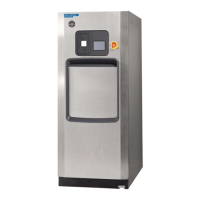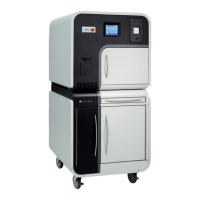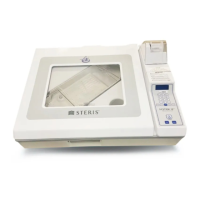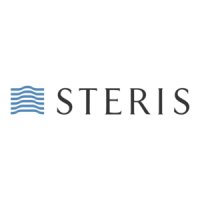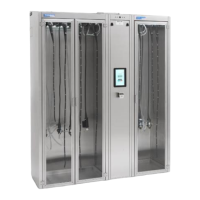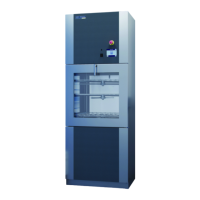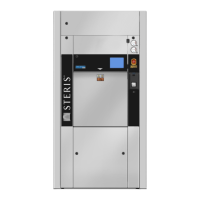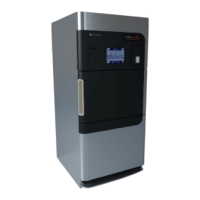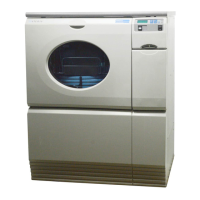Do you have a question about the Steris Basil 4700 and is the answer not in the manual?
Important safety precautions and information regarding equipment alteration.
Specifies the intended applications and approved uses of the washer.
Details the importance of preventive maintenance and STERIS service options.
Lists the standards the washer complies with, such as UL and CSA.
Hazards related to improper maintenance, unqualified personnel, or unauthorized parts.
Precautions to prevent physical harm during operation and cleaning.
Hazards associated with handling caustic detergents and chemicals.
Safety measures for electrical hazards during servicing and operation.
Precautions regarding hot components and surfaces during operation.
Measures to prevent slips from spills or condensation.
Warnings to prevent damage to the equipment through incorrect usage or maintenance.
Additional cautions to prevent equipment damage from improper cleaning or chemical use.
Details electrical requirements, environmental conditions, and noise levels.
A checklist to ensure the washer installation is complete and correct.
Details the specifications for chemical additives and recommends specific STERIS products.
Provides an overview of the washer's components and their general function.
Describes the operator terminal, its modes, and functions.
Explains the operation and positions of the key switch for controlling washer access.
Provides information about the printer, its use, and specifications.
Illustrates examples of typical printouts from the washer, including power up, cycle start, and alarms.
Describes the oscillating jet system responsible for spraying water inside the chamber.
Details the safety features of the washer, including door switches, safety cables, and emergency stop buttons.
Explains the function of the steam heat exchanger in preheating water for the washer.
Describes the automatic system for injecting detergent into the chamber sump.
Explains the system for managing reusable or disposable detergent solutions.
Details the system for spraying fresh water during the final rinse phase.
Describes the system for washing feeder bottles as an accessory.
Explains the automatic system for flushing watering racks.
Describes the system for retaining and cooling drain discharges with temperature control.
Explains the cooldown system using only cold water injection.
Describes the exhaust fan's role in removing vapors from the wash chamber.
Steps to perform before starting the washer to ensure proper operation and safety.
Guidelines for safely and correctly loading items into the washer.
Details the process of operating a wash cycle, including phase descriptions.
Instructions on how to review and print programmed cycle data.
Procedure for temporarily extending the duration of a cycle phase.
How to skip or bypass a specific phase within a cycle.
Steps for properly shutting down and cleaning the washer after use.
How to access and use the manual control mode for specific functions.
Guidance on how to respond to alarm messages and fault conditions.
How to pause an ongoing cycle and resume or abort it.
Procedure for stopping or aborting an active cycle.
Information regarding the washer's shutdown procedure.
Steps to take after a power failure to resume operation.
Overview of PLC control for customizing wash cycles.
Details on accessing and using the Supervisor mode for settings.
Instructions for modifying cycles, including changing names, icons, and parameters.
General safety warnings related to maintenance procedures.
Safety precautions for preventing electrical shock during maintenance.
Warnings about hot components during maintenance.
A guide for scheduling periodic inspections and maintenance.
Daily tasks for cleaning the washer to maintain its condition and performance.
Recommended weekly cleaning tasks for the washer's exterior and interior.
Monthly procedure to remove hard water deposits from the chamber and accessories.
General routine maintenance procedures.
Instructions for changing the printer paper roll.
Procedure for changing the printer ribbon cartridge.
Introduction to troubleshooting, covering malfunctions, causes, and corrections.
Lists problems, causes, and corrections for non-alarm situations.
Lists faults that trigger alarms and their possible causes and corrections.
A list of common parts and their part numbers for minor maintenance.
Instructions for service technicians to access the Service mode.
Steps to configure washer settings and hardware options in Service mode.
Procedures for testing washer inputs and outputs.
Procedures for calibrating controller output signals for sensors.
Information and procedures related to the Thornton controller.
How to enable or disable the printer via Supervisor mode.
Instructions for changing the Supervisor password.
Describes the initial steps of the start-up cycle for the washer.
Explains the sequence of phases in a typical wash cycle.
Details the processing of different phases within a cycle.
Describes how detergent is injected into the washer based on time or conductivity.
Monitors the sump heating process and activates steam valve when needed.
Describes the soaking phase for acid washes.
Details the draining process, including cooldown and header drain.
Explains the water save feature, including header drain.
Details the process of neutralizing sump pH using injection pumps.
Explains the functionality of the guaranteed cooldown tank option.
Describes the operation of the header system, including reversing and forward positions.
Explains the bottle wash option and its operation.
Details how the washer's functions are monitored during the cycle.
Monitors the alkaline wash tank filling and heating.
Monitors the acid wash tank filling and heating.
Miscellaneous operational notes and tips.
Describes how to use the Manual Control mode for washer functions.
General information regarding preventive maintenance and troubleshooting.
A guideline for scheduling periodic inspections and maintenance.
Daily cleaning tasks to maintain the washer.
Recommended weekly cleaning procedures for the washer.
Monthly cleaning tasks, including hard water deposit removal.
General routine maintenance procedures.
Information regarding the printer paper and its replacement.
Procedure for changing the printer ribbon cartridge.
General guidelines for performing tests and inspections on the washer.
Lists the necessary instruments for conducting field tests.
Basic checks to perform before starting field tests.
Procedures for testing the washer's operational and safety functions.
How to test the washer's inputs and outputs.
Steps to follow for the initial start-up of the washer after installation.
Introduction to component disassembly, repair, and replacement procedures.
Procedures for servicing the washer doors.
Steps for replacing the interior light lamp.
Information about the chemical injection pump and its components.
Maintenance and adjustment of the carriage drive system.
Lubrication procedure for the pump motor.
How to verify the tension of the safety cables.
How to remove tubing from pneumatic fittings.
Procedure for replacing a faulty thermostatic steam trap.
How to adjust the heat exchanger controls for fill water temperature.
Steps for replacing the pH controller.
Procedure for calibrating controller output signals.
Adjustments for the pH controller, including reset, frequency, measure units, and analog output.
Steps for replacing the pH sensor.
Information on replacing the RTD sensors used for temperature measurement.
Guidance on how to use the illustrated parts breakdown section.
Information on preventive maintenance packs for ordering repair kits.
Important safety precautions and information regarding equipment alteration.
Specifies the intended applications and approved uses of the washer.
Details the importance of preventive maintenance and STERIS service options.
Lists the standards the washer complies with, such as UL and CSA.
Hazards related to improper maintenance, unqualified personnel, or unauthorized parts.
Precautions to prevent physical harm during operation and cleaning.
Hazards associated with handling caustic detergents and chemicals.
Safety measures for electrical hazards during servicing and operation.
Precautions regarding hot components and surfaces during operation.
Measures to prevent slips from spills or condensation.
Warnings to prevent damage to the equipment through incorrect usage or maintenance.
Additional cautions to prevent equipment damage from improper cleaning or chemical use.
Details electrical requirements, environmental conditions, and noise levels.
A checklist to ensure the washer installation is complete and correct.
Details the specifications for chemical additives and recommends specific STERIS products.
Provides an overview of the washer's components and their general function.
Describes the operator terminal, its modes, and functions.
Explains the operation and positions of the key switch for controlling washer access.
Provides information about the printer, its use, and specifications.
Illustrates examples of typical printouts from the washer, including power up, cycle start, and alarms.
Describes the oscillating jet system responsible for spraying water inside the chamber.
Details the safety features of the washer, including door switches, safety cables, and emergency stop buttons.
Explains the function of the steam heat exchanger in preheating water for the washer.
Describes the automatic system for injecting detergent into the chamber sump.
Explains the system for managing reusable or disposable detergent solutions.
Details the system for spraying fresh water during the final rinse phase.
Describes the system for washing feeder bottles as an accessory.
Explains the automatic system for flushing watering racks.
Describes the system for retaining and cooling drain discharges with temperature control.
Explains the cooldown system using only cold water injection.
Describes the exhaust fan's role in removing vapors from the wash chamber.
Steps to perform before starting the washer to ensure proper operation and safety.
Guidelines for safely and correctly loading items into the washer.
Details the process of operating a wash cycle, including phase descriptions.
Instructions on how to review and print programmed cycle data.
Procedure for temporarily extending the duration of a cycle phase.
How to skip or bypass a specific phase within a cycle.
Steps for properly shutting down and cleaning the washer after use.
How to access and use the manual control mode for specific functions.
Guidance on how to respond to alarm messages and fault conditions.
How to pause an ongoing cycle and resume or abort it.
Procedure for stopping or aborting an active cycle.
Information regarding the washer's shutdown procedure.
Steps to take after a power failure to resume operation.
Overview of PLC control for customizing wash cycles.
Details on accessing and using the Supervisor mode for settings.
Instructions for modifying cycles, including changing names, icons, and parameters.
General safety warnings related to maintenance procedures.
Safety precautions for preventing electrical shock during maintenance.
Warnings about hot components during maintenance.
A guide for scheduling periodic inspections and maintenance.
Daily tasks for cleaning the washer to maintain its condition and performance.
Recommended weekly cleaning tasks for the washer's exterior and interior.
Monthly procedure to remove hard water deposits from the chamber and accessories.
General routine maintenance procedures.
Instructions for changing the printer paper roll.
Procedure for changing the printer ribbon cartridge.
Introduction to troubleshooting, covering malfunctions, causes, and corrections.
Lists problems, causes, and corrections for non-alarm situations.
Lists faults that trigger alarms and their possible causes and corrections.
A list of common parts and their part numbers for minor maintenance.
Instructions for service technicians to access the Service mode.
Steps to configure washer settings and hardware options in Service mode.
Procedures for testing washer inputs and outputs.
Procedures for calibrating controller output signals for sensors.
Information and procedures related to the Thornton controller.
How to enable or disable the printer via Supervisor mode.
Instructions for changing the Supervisor password.
Describes the initial steps of the start-up cycle for the washer.
Explains the sequence of phases in a typical wash cycle.
Details the processing of different phases within a cycle.
Describes how detergent is injected into the washer based on time or conductivity.
Monitors the sump heating process and activates steam valve when needed.
Describes the soaking phase for acid washes.
Details the draining process, including cooldown and header drain.
Explains the water save feature, including header drain.
Details the process of neutralizing sump pH using injection pumps.
Explains the functionality of the guaranteed cooldown tank option.
Describes the operation of the header system, including reversing and forward positions.
Explains the bottle wash option and its operation.
Details how the washer's functions are monitored during the cycle.
Monitors the alkaline wash tank filling and heating.
Monitors the acid wash tank filling and heating.
Miscellaneous operational notes and tips.
Describes how to use the Manual Control mode for washer functions.
General information regarding preventive maintenance and troubleshooting.
A guideline for scheduling periodic inspections and maintenance.
Daily cleaning tasks to maintain the washer.
Recommended weekly cleaning procedures for the washer.
Monthly cleaning tasks, including hard water deposit removal.
General routine maintenance procedures.
Information regarding the printer paper and its replacement.
Procedure for changing the printer ribbon cartridge.
General guidelines for performing tests and inspections on the washer.
Lists the necessary instruments for conducting field tests.
Basic checks to perform before starting field tests.
Procedures for testing the washer's operational and safety functions.
How to test the washer's inputs and outputs.
Steps to follow for the initial start-up of the washer after installation.
Introduction to component disassembly, repair, and replacement procedures.
Procedures for servicing the washer doors.
Steps for replacing the interior light lamp.
Information about the chemical injection pump and its components.
Maintenance and adjustment of the carriage drive system.
Lubrication procedure for the pump motor.
How to verify the tension of the safety cables.
How to remove tubing from pneumatic fittings.
Procedure for replacing a faulty thermostatic steam trap.
How to adjust the heat exchanger controls for fill water temperature.
Steps for replacing the pH controller.
Procedure for calibrating controller output signals.
Adjustments for the pH controller, including reset, frequency, measure units, and analog output.
Steps for replacing the pH sensor.
Information on replacing the RTD sensors used for temperature measurement.
Guidance on how to use the illustrated parts breakdown section.
Information on preventive maintenance packs for ordering repair kits.
| Brand | Steris |
|---|---|
| Model | Basil 4700 |
| Category | Laboratory Equipment |
| Language | English |
